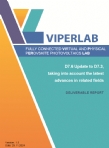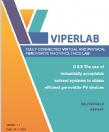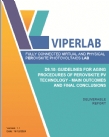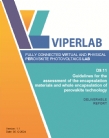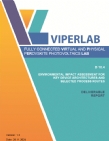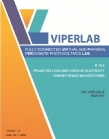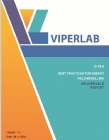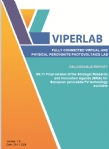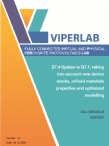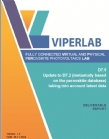Technical documents
This VIPERLAB-KEP web area offers documentation produced by VIPERLAB partners or already available by different sources to any interested researcher , professional, stakeholder/decision maker, student. The list of documents can be sorted by different criteria (by organization, by PV RTD technology, by PV RTD topic, by PV RTD Equipment)
Search
This report presents an overview of the current advancements in the field of photovoltaic (PV) technologies, with a special focus on perovskite-based systems. These materials have shown promising potential across a range of applications, including solar cells (PV), light-emitting diodes (LEDs), and detectors. In the realm of PV technologies, perovskite quantum dots (PeQDs) have been utilized to enhance the efficiency of solar cells, demonstrating notable records in performance. However, there are still some challenges, such as the need for ligand exchange processes and the choice of solvents, which need to be addressed for their wider implementation.
Edited : 26/12/2024
This report will explore the various green solvent process routes currently being developed at partners institutions and evaluated within the context of perovskite PV device fabrication. By examining these routes, the report aims to identify the most promising methods for industrialization, considering both environmental impact and scalability. The insights gained from this analysis will contribute to the broader objective of creating a sustainable and competitive European perovskite PV industry, poised to lead the global market with innovative, eco-friendly technologies.
Edited : 26/12/2024
This deliverable report presents the key findings and guidelines derived from the VIPERLAB project’s extensive aging studies on perovskite photovoltaic (PV) technologies. These studies explored the effects of critical stress factors—light, temperature, and humidity—on various perovskite PV device architectures, including single-junction devices with NIP or PIN structures and tandem perovskite-silicon devices. Both accelerated aging and outdoor experiments were conducted to simulate real-world conditions and predict long-term stability. This report emphasizes the need for harmonized protocols to enhance reliability, scalability, and standardization of perovskite PV devices, providing a foundation for future research and development in this rapidly evolving field.
Edited : 26/12/2024
Perovskite solar cells are highly promising for next-generation photovoltaics but are particularly vulnerable to environmental factors like moisture, oxygen, and temperature changes. Encapsulation is essential to protect the delicate perovskite layers, ensure device longevity, and maintain high efficiency. This report explores various encapsulation methods, focusing on lamination processes and thin-film techniques, which are particularly relevant for industrial applications. Lamination involves using thermo-fusible polymers or UV-curable adhesives to seal protective covers, while thin-film encapsulation employs advanced deposition techniques like ALD and PECVD to create dense barrier layers.
Edited : 26/12/2024
This report D10.4 presents the insights and methodology in life cycle assessment from four members of the project consortium – Fraunhofer, CEA, CENER and HZB for both single and multi-junction photovoltaic technologies. The aim is to provide the environmental impacts and their hotspots, specifically in the case of new technologies like perovskite and perovskite-silicon tandem solar cells and modules. Due to the use of critical material, it is important to understand not only the global warming potential of new photovoltaic technologies but also the impact on human toxicity and resource depletion.
Edited : 26/12/2024
this deliverable report will mainly focus on an introduction to the technologies evaluated and the methods followed to carry out the LCOE assessment and not contain any detailed results to maintain novelty and not hinder efforts to publish and/or present the results at a conference. However, the results of the analysis were presented and discussed with the project consortium at the final general assembly meeting held in Brussels in November 2024 and are briefly mentioned in this report.
Edited : 26/12/2024
This report presents the insights and methodology in energy yield modelling from three members of the project consortium – Fraunhofer, CENER and HZB for both single and multi-junction photovoltaic technologies. The aim is to provide a consolidated view of their available energy yield models to obtain better and more accurate energy yield estimates, specifically in the case of new technologies like perovskite and perovskite-silicon tandem solar cells and modules. The report details the current status and challenges related to tandem energy yield modelling including luminescence coupling between top and bottom cells, temperature dependence, stability and degradation amongst others as critical topics in need of further investigation.
Edited : 26/12/2024
Central to the drafting of the VIPERLAB SRIA was the organisation of two workshops. The first strategic VIPERLAB workshop (D6.2) was organized in September 2022 as a parallel event to the WCPEC-8 conference in Milano, Italy. The second strategic VIPERLAB workshop was organized on the 22nd of March 2023 during the "Energy Conversion and Storage Days" event organized by the Karlsruhe Institute of Technology (KIT) in Karlsruhe, Germany. The results of these two workshops together with the perovskite-PV chapter of the EU SRIA-PV drafted by ETIP-PV and EERA-PV formed the basis of the VIPERLAB SRIA on single-junction perovskite PV. This VIPERLAB SRIA was further fine-tuned during the final year of the project via public consultations with stakeholders at various events.
Edited : 26/12/2024
Report D7.4 is an update of the confidential report D7.1 which outlined simulation guidelines for improving the optical and electrical performance of perovskite and perovskite-silicon tandem solar cells within the VIPERLAB consortium. It describes three rounds of comparative simulations that examined various tools to identify their strengths, limitations, and differences. The findings of D7.1 emphasized the importance of critical parameters such as material properties, layer thicknesses, and doping levels in achieving optimal device efficiency.
Edited : 26/12/2024
One of the main focuses of this task was the broader adoption of FAIR (Findable, Accessible, Interoperable, and Reusable) data principles in the perovskite PV community. A central achievement of has been the establishment of the Perovskite Database, an open-access platform that compiles metadata and performance metrics from over 16,000 publications. This initiative has provided the research community with a valuable resource for analyzing trends, identifying gaps, and fostering collaboration.
Edited : 26/12/2024


